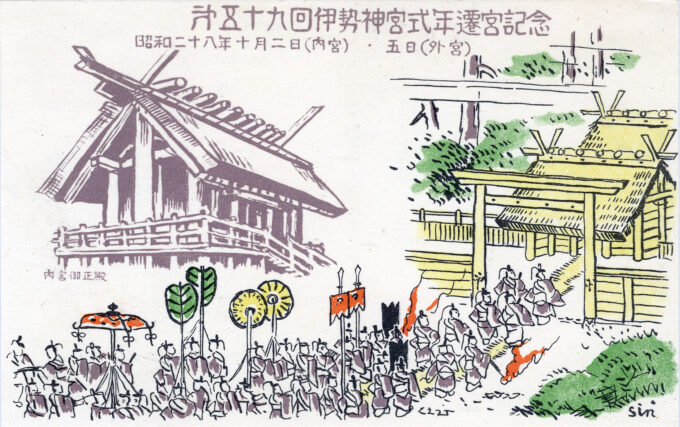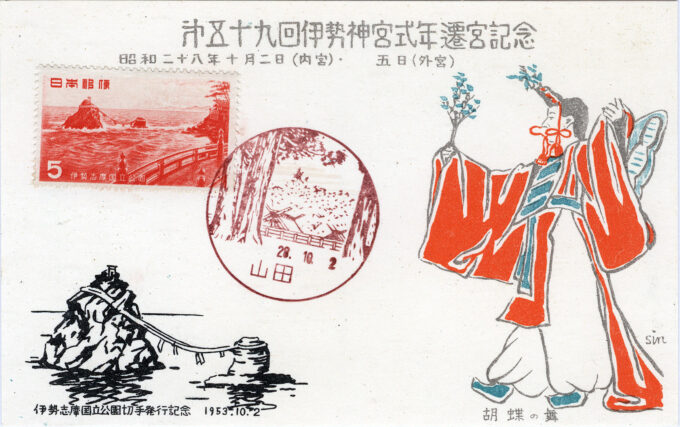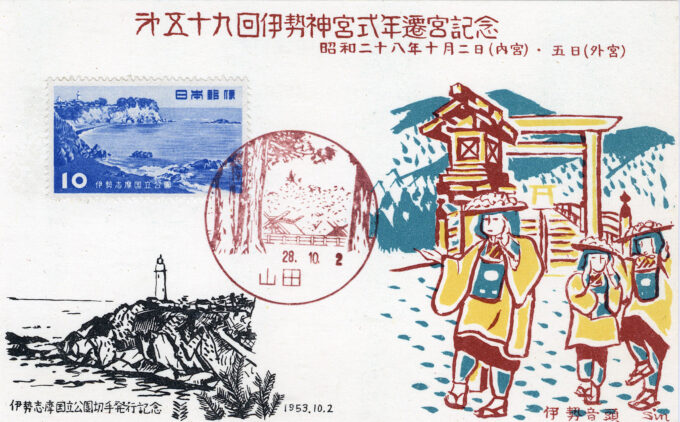
59th Ise Jingu Shikinen Sengu Anniversary commemorative postcard, 1953. The traditional shrine rebuilding, Shikinen Sengu, takes place every 20 years. The Inner Shrine, Naikū, dedicated to the worship of Amaterasu, is held in the highest reverence of all Shinto shrines because it is home to the Sacred Mirror (Yata no Kagami). Besides the traditional establishment date of 4 B.C.E. other dates of the 3rd and 5th centuries have been put forward for the establishment of Naikū and the outer shrine, Gekū, respectively. The first shrine building at Naikū was erected by Emperor Tenmu (678–686), with the first ceremonial rebuilding being carried out by his wife, Empress Jitō, in 692. The rebuildings in 1953 took place in October (for the Inner Shrine) and May (for the Outer Shrine). The most recent Shikinen Sengu took place in 2013 and the next is scheduled for 2033.
“I learned in September 1953 that the renewal of the Great Shrine at Ise, normally performed every twenty years but delayed this time because of the war, was to take place the next month. At the end of The Narrow Road of Oku, Basho mentions going to Ise to witness this ceremony and I was eager to follow in his footsteps.
“I had no idea how to get invited to the ceremony, so I visited the nearest major Shinto shrine, the Kitano Temmangu, to ask for advice. I met the chief priest and this led to establishing friendly relations with him and his family that lasted throughout my stay in Kyoto. In October we went together to Ise.
Meoto Iwa (Wedded Rocks), Ise City, Mie Prefecture. 59th Ise Jingu Shikinen Sengu Anniversary First Day Issue, 1953. Illustrated is the kocho no mai [‘butterfly dance’] that highlights the annual Ise Jingu Spring Kagura Festival.
“The beauty of Ise, from my first glimpse of the Isuzu River and the magnificent trees, quite overwhelmed me. There had been a heavy rain the night before, but the water in the river was pellucidly clear. I followed the other worshippers in washing my hands and rinsing my mouth before approaching the shrine buildings along the gravel path. I had visited other Shinto shrines, but the experience here seemed totally different because of the special, holy atmosphere.
“When I reached the Great Shrine, I followed the others in dropping a coin in a wooden box. No — it was probably a bill rather than a coin; in those days the only coins were of 5 or 10 yen and 10-yen bills were more common than coins. I bowed my head and clapped my hands. I don’t remember what I prayed for. It could hardly have been for more than what I was actually enjoying, the peace and beauty of Ise.
Daiosaki Lighthouse, Shima, Mie Prefecture, 59th Ise Jingu Shikinen Sengu Anniversary First Day Issue, 1953, highlighted by an illustration of traditional Ise ondo [‘folk song’] performers.
“The ceremony of the renewal of the shrine would not take place until it grew dark, but for hours before people sat on matting, patiently waiting. The invitations to the ceremony specified that men must wear either formal Japanese costume or morning suits, while women had their choice of monzuki (crested kimono) or a robe montante. I am not sure I would recognize a robe montante if I saw one, but it was evident that the people around me, dressed for the most part in nondescript clothes, could not afford such costumes … There were attendants who wore crude clothing, like a woman wearing a skirt made of furoshiki (wrapping cloth) with arabesque patterns. However, not a single person spoke in the sacred atmosphere, and we were enveloped in complete silence.
“After some hours of waiting I was startled to hear a loudspeaker bray, ‘Donarudo sama! Donarudo sama!’ I decided that the name being called [‘Donald’] must be my own, and went where the loudspeaker directed. A seat had been found for me among the dignitaries, and I was to leave my place on the matting. I asked why I had been summoned by my first name rather than by my surname, and someone replied, ‘If we asked for Keene, people might think a Korean had come.’ (As pronounced in Japan, ‘Keene’ sounds rather like ‘Kim,’ a common Korean surname.) This response was so surprising and so unworthy of the occasion that I could think of nothing to say.
“… The ceremony began with the faint sounds of gagaku, the ancient ritual music, and torch flares in the total darkness. Slowly one torch was joined by others, and a procession wound its way down the stone steps of the old shrine to the gravel path leading to the new shrine.
“The climax of the procession was when the divinity was moved to the new shrine inside a long silk canopy borne by the priests. As the canopy passed before the worshippers, they clapped their hands in reverence, and a wave of sound moved laterally in parallel with the procession, dying out in one section of worshippers to be taken up by the next.
“Of all the religious ceremonies I have seen in Japan, this moved me most.”
– On Familiar Terms: A Journey Across Cultures, by Donald Keene, 1994



